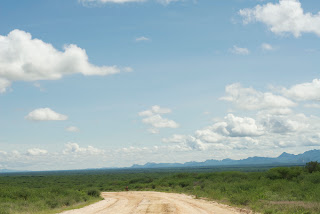We reach the tarmac and life starts to be easy again! From Marich Pass in northern Kenya, we head on a direct way through Kitale, Eldoret and Nakuru to Nairobi. The road becomes more and more crowded with people and traffic. We enjoy the civilization and try not to get driven over.
In Nairobi we stay at Judith and Thomas' place: lovely and welcoming! We spend 2 lovely days chatting and learning about their stay in "Nairobbery"! Their fortress-compound-appartment is impressive and we don't know if we could/would live locked up like this... There is a huge gap in inequality between the slums and the rich people (black and white people) living within stone throwing distance!
Our road out of Nairobi takes us through Ngong, Karen, Kiserian, Kajiado and finally Namanga at the border to Tansania.
Everyone in Kenya seems to be preoccupied with safety and security. The sentence most said when we book a hotel is "This is a secure place, you will have no problem. It is safe." How strange to hear this after having travelled 10'000 km and camped so many times without anyone looking for our security. Is the world really such a dangerous place or are we all afraid of the other one we don't know? (look at Israel).
Another impressive observation: there are literally hundreds of churches praising their services like "redemption for 100 Kenyan Shilling", "salvation for 150 KSh", .... either Kenyans are really big sinners or there is an economy of bad conscious or it is a big lie... (you choose!)
Kenyans impress us with their knowledge of the world, their fluency in English and an incredible amount of languages they speak. We met a mountain guide who spoke 8 languages!!!
 |
| The concerned lady will get the message right: "Feed her, M., feed her! If necessary with swiss organic powder milk!" |
 |
| school break at lunch time watching the 2 crazy Muzungu cycling in the heat! |
 |
| Tarmac! Tarmac! Tarmac! |
 |
| Lots of body guards for the lady! This time at a respectful distance and not shouting. And not throwing stones! |
 |
| Somewhere in the crowd there is a lady explaining our cycled kilometers! |
 |
| That's a mission! |
 |
| school is over |
 |
| lonesome bicycle along the main road |
 |
| road repairs. Some roads badly need it. |
 |
| Finally, finally, most probably the right way to go! |
 |
| Hard labour making gravel |
 |
| Kenyan faces |
 |
| There are lots of bicycles in Kenya |
 |
| the last 4-digital-number |
 |
| This gentleman speaks perfect English, is 90 years old and lived during the British colonial time! What a historical catch up! |
 |
| I promise I will never complain about going to the office on a Monday morning again! |
 |
| YES! |
 |
| "No, no, my bicycle is not going through the mud! I'd rather have MY shoes dirty and muddy!" |
 |
1. do you see it?
2. guess the size |
 |
| Zebras (yes, we know that you know!) which Yann passed by without seeing! He was really concentrated on the road! |
 |
| how many? |
 |
| (Imagine a whiny voice) "I once had a bicycle at the foot of the Ngong Hills in Africa!" |
 |
| It's the rainy season |
 |
| There are boys and monkeys on this picture... can you find them? |




































































































